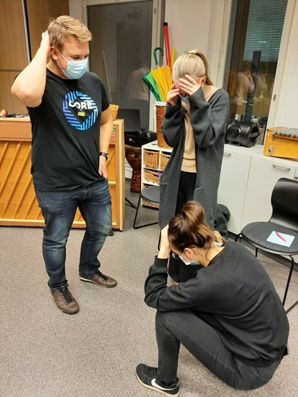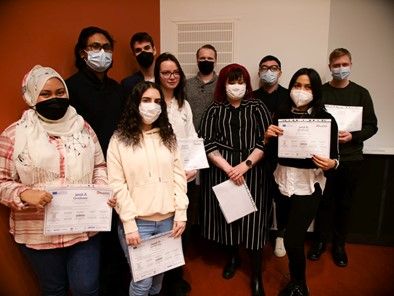Processing Complexity
Simple problems can be solved with common analytic methods like data collection and analysis. Solving simple problems happens usually by defining the problems more precisely or by breaking them into smaller parts. These parts can be solved in isolation by different people, and it is possible to integrate the partial solutions to a bigger into an overall solution. This is possible because there are no significant interconnections between the parts and all participants share the same values and targets. (Rittel & Webber, 1973; Roth & Senge, 1996.)
Complex problems are the opposite of simple problems that can be laborious but are always solvable. Complex problems involve many parties that have their own needs, values, and priorities. It is very hard to find a solution for complex problems because the problem changes every time it is tried to be solved. There are no prior solutions that could be utilized when solving a new problem because problems tend to be unique. It is also very hard to estimate how the attempt to solve the problem has succeeded. (Camillus, 2008.)
Management of complexity
Organizations encounter complex problems usually when they face continuous change or unforeseen challenges. This can happen anywhere: in strategic development, in product management or in design. (Camillus, 2008; Christensen, 2009.) In complex environment, the parties lack common world view, common values or common ethics, and people are looking at the problem from different perspective and planning strategies (Geertz, 1973). As the complexity of context increases, organizations must increase their own complexity to correspond the complexity level of the environment, because “it takes complexity to defeat complexity” (Uhl-Bien & McKelvey, 2007).
Complexity as such is not a bad thing. It brings opportunities as well as challenges, and the latter ones are usually caused by the way companies attempt to respond to complexity. (Morieux, 2011.) However, complexity can also offer tremendous opportunities for companies if they can properly address it (Czinki & Hentschel, 2016).
Many authors (Morin, 2014; Boulton, Allen & Bowman, 2015) have raised the question of the management of complexity, agreeing that the apprehension of complex problems presupposes not remaining within a rational approach, but rather benefits from other approaches such as art, spirituality, or philosophy. This involves the mobilisation of various human capacities other than exclusively rational thought. However, few companies take these approaches into account. The solutions that have been provided by so far can almost exclusively be considered as a mere means of support in stress reduction and in helping an individual find balance, rather than as a real performance factor and a response to dealing with complexity. There is thus a need for the mobilisation of all kinds of capacities; sensorial, emotional and spiritual, so that they may be implemented in organisations and in management training as vital factor affecting performance.
ProCESS project between higher education institutions and companies
ProCESS (Processing Complexity with Emotional, Sensorial and Spiritual capacities) is a three-year long educational project that invents new ways of training both students and current managers on how to address complexity, the main lever being the development of “SES (Sensorial / Emotional / Spiritual) skills”, on an equal basis with hard skills. ProCESS project aims at tackling the challenge of decision making in organizations because decision making based on facts and rational approaches is no longer sustainable in complex environment.
There are four higher education institution partners and five company partners in the project. The higher education partners are JAMK University of Applied Sciences from Finland, Catholic University of Lyon from France, RISEBA University of Business, Arts and Technology from Latvia and Technical University of Cluj Napoca from Romania. The higher education partners’ goals are to ensure the employability of graduates and make the graduates more efficient in a complex working environment by helping them to become creative and innovative individuals.
Companies are the centrepiece of ProCESS. They provide complex situations in which ProCESS methodology can be experimented and ProCESS training modules can be tested. Each company contributes to the definition of three complex management cases, one per year, and to their presentation to students, to co-coaching of 12 transnational groups of students, and to leading of the winter school jury which evaluates the quality of the action plans proposed by the students. The companies in the project are Sanofi from France, DE Klausen from Romania, Mediahouse Keskisuomalainen from Finland and Latvia’s National Post from Latvia. PerformanSe from France takes care of the evaluation of the project.
ProCESS involves 192 students from each higher education institution, who are coached by academic and company coaches, and by a varying number of SES skills trainers. The development of ProCESS’ training modules is planned in cooperation with companies and thus, the project outcomes will improve the quality and efficiency of education by matching the learned skills with the requirements of working life.

JAMK students getting prepared for their case resolution
Expected results of the project
ProCESS will deliver a methodology to respond to changing needs in the wider economy and shape the careers of tomorrow; prepare individuals for varied and unpredictable career paths, training them in skills such as the ability to think critically, take initiative, solve problems, and work collaboratively. It is necessary to improve the correspondence between the training of managers and the reality of managing within complexity.
Higher education institutions lead ProCESS’s innovative model, involving students, current managers, and SES skills trainers. They contribute to the organisation and co-coaching of 12 transnational groups of students including the provision of an adequate academic framework mobilizing one academic coach per higher education institution, the organisation of three winter schools and the setting up of a new model for management training that will be tested, evaluated, improved, and disseminated.

JAMK students with their certificates after the winter school in JAMK in January 2022
The innovative nature of ProCESS reveals itself through systematically combining non rational and rational skills, fostering a holistic approach, giving a real place to SES skills in management training and in businesses, convening standardized workshops which summon the sensory, the emotional and the spiritual, to address real complex cases. The aim of ProCESS is to teach current and future managers to break out of traditional thought patterns, complement traditional methods of analysis, upset students’ established intellectual order, and broaden their perspectives. Indeed, ProCESS has multicultural inputs, approaches and heterogeneity that lead to the analysis of situations from different points of view and sensitivities, and therefore a proliferation of ideas and the restitution of a broad range of solutions which will infuse companies from various sectors.
Benefits of the project
Benefits for higher education institutions in short term are the development of the SES skills of the students, the readiness to use SES skills training modules to be exploited in bachelor and master programmes, the ability to gather a SES skills trainers’ network, the readiness to offer expertise in dealing with complex cases, and the ability to provide standard cases that are re-usable in academic contexts. Long term benefits include the attraction of new students, the reinforcement of links with companies, the mobility of SES skills trainers between partner higher education institutions, and the provision of general and tailored training for companies.
Benefits for companies in the short term are action plans for 12 cases (four companies and three cases), testing the ProCESS methodology, challenging the managers with new training methods, gaining new management skills, identifying potential new employees (future leaders) among participating students, and valuable new contacts and impulses for further cooperation. Long term benefits include contribution to the social responsibility of enterprises, better relations between managers and staff, declined staff turnover, attractiveness for millennials, and visibility through ProCESS outputs.
Anne Eskola D.Sc., JAMK, ProCESS academic coach
Anneli Kakko M.Sc., JAMK, ProCESS project manager
Ari Korhonen, M.Sc., JAMK, ProCESS SESS trainer
Marcella Zoccoli, MBA, JAMK, ProCESS SESS trainer
References
Boulton, Jean G., Allen, Peter M. & Bowman Cliff. (2015). Embracing Complexity – Strategic Perspectives for an Age of Turbulence. Oxford University Press, United Kingdom.
Camillus, J. C. (2008). Strategy as a Wicked Problem. Harvard Business Review 86(5), 98–106.
Christensen, K. (2009) Building Shared Understanding of Wicked Problems – Interview of Jeff Conklin. Rotman Magazine, Winter, 17–20.
Czinki, A. & Hentschel, C. (2016). Solving complex problems and TRIZ. Procedia CIRP 39, 27–32.
Geertz, C. (1973). The Interpretation of Cultures: Selected Essays. New York: Basic Books.
Morieux, Y. (2011). Smart Rules: Six Ways to Get People to Solve Problems Without You. Harvard Business Review, September 2011.
Morin, E. (2014). Complex Thinking for a Complex World – About Reductionism, Disjunction and Systemism. Systema, 2(1), 14–22. Retrieved 31 August 2021 from ComplexThinkingforaComplexWorldAboutReductionismDisjunctionandSystemismEdgarMorin257-1036-1-PB (3).pdf.
Rittel, H. W. J. & Webber, M. M. (1973). Dilemmas in a General Theory of Planning. Policy Sciences 4, 155–169. Scotland: Elsevier.
Roth, G. L., & Senge, P. M. (1996). From theory to practice: research territory, processes and structure at an organizational learning centre. Journal of Organizational Change Management 9(1), 92–106.
Uhl-Bien, M., Marion, R. & McKelvey, B. (2007). Complexity Leadership Theory: Shifting leadership from the industrial age to the knowledge era. The Leadership Quarterly 18(4), 298–318.